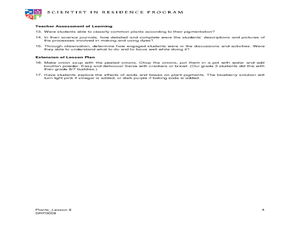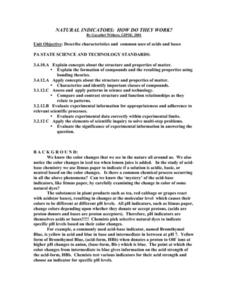Curated OER
Natural Dyes From Plants
Students investigate how natural dyes from plants was an expression of Native American cultures. They examine objects dyed from natural sources, conduct Internet research, and create their own dyes using various plant sources.
Alabama Wildlife Federation
Colors to Dye for!
Nature provides a rainbow of colors at one's fingertips. A hands-on activity uses natural plant materials to create all-natural dyes. Plants range from fruits and vegetables to flowers and greens. After extracting the pigments, eager...
Curated OER
fun with Plants that We Use
Students become familiar with the products made from various plants. In this plants lesson, students experiment with natural dyes from plants. Students complete a list of things made from plants. Students answer questions about plant...
Curated OER
Natural Dyeing with Plants - Scientific Method
Students study the components of scientific investigation by planning and carrying out an experiment in natural dyeing, seeing if different kinds of metal dye pots affect the color one gets from the same plant material.
Curated OER
Using Plant Pigments as Natural Dyes
Students create friendship bracelets and quilt squares. In this plant lesson student dye their own string and cotton material with plant pigments. Students use the naturally dyed materials to create the friendship bracelets and quilt...
Curated OER
Coloring Fabrics With Dyes from Plant Materials K-12 Experiments & Background Information
Students investigate the effects of acid and bases on dyes made with plant materials. In this chromatography lesson students predict color outcomes and complete a lab activity on color combinations.
Curated OER
Natural Indicators: How Do They Work?
Students describe characteristics and common uses of acids and bases. They describe the role of natural indicators in the chemistry of acids and bases after testing and making observations on a variety of plant extracts. Students observe...
Curated OER
First Nations Plants and their Uses
Students identify the uses of plants by researching Native Americans. In this First Nations culture lesson, students identify the First Nations coastal people of British Columbia and their use of plants such as seaweed, bark and moss....
Curated OER
Plant Dye Paints
Students create original paintings using natural dye techniques used in the past in this Art lesson about paint colors. The lesson may be supplemented with information about pioneers, or ancient civilizations, and how paints were made...
Curated OER
Plant Activities: To Dye For
Students use natural plant dyes to color their clothing as they did in the past.
Teach Engineering
Glowing Flowers
What a bright idea! Young scientists conduct an experiment on flowers to finish the last of a six-lesson unit on Cells. Putting the stems into dye-injected water and leaving it overnight results in flowers that glow. This is to simulate...
National Institute of Open Schooling
Nomenclature and General Principles
Carbon, the base for all organic compounds, exists in nature in its purest form as graphite or diamonds. The 25th lesson in a series of 36 teaches pupils the nomenclature of organic compounds. Learners read about how to use the IUPAC...
Curated OER
Land Issues
For this unit of lessons, students examine land issues affecting the world today. They discover what it is like for animals to live and create paper animals. They also examine parts of a tree and how to make dyes from materials found in...
Curated OER
Suitcase, Parfleche and 'Isaptakay
Third graders explore farfeche and how the Nez Perce people use natural materials to derive colors for their artwork. They explore traditional paints and dyes used by the Nez Perce and create their own parfleche 'isaptakay.
Curated OER
Hands-on with Wool
Students understand how to spin wool. In this spinning wool instructional activity, students recognize how to ply and dye wool. Students understand that this is the process used years ago.
Curated OER
Ozone Pollution: Smog Alert
Students simulate the development of smog. They discover how it forms naturally in nature. They read news articles about the ozone and pollution. They discuss what they can do to lower the pollution they generate.
Global Oneness Project
Rethinking the Fabrics We Wear
What are fibersheds and what what do they have to do with environmental protections? A photo essay and audio recordings about Mimi Luebbermann, and her sheep, cause consumers to reflect on how their clothing choices can support local...
Curated OER
Celebrate Sunflowers
Students skip count with sunflower seeds. In this interdisciplinary lesson, students discuss the history of sunflowers. Students count by 1's, 2's, and 10's with bags full of sunflower seeds.
Curated OER
Soak it up
Young scholars complete a hands on activity using hard boiled eggs, food coloring, tape, cups, water, and a knife to show how permeability affects animals. For this permeability lesson plan, students complete this activity and learn how...
Curated OER
The Water Cycle
Students are introduced to the components and importance of the water cycle. They are shown how groundwater moves using a model. Students list 9 places on earth where water is found. They define the terms cycle and water cycle.
Curated OER
Catch As Catch Can
Students capture and observe insects. Using provided netting, students design and create a butterfly net. They study many types of insects and their benefits. After identifying insects caught, students complete a graph. Students write...
Curated OER
Catch as Catch Can
Pupils investigate insects. For this insect analysis lesson, students catch insects using nets they make. They identify the insects they catch and create a chart to show the numbers and varieties. This lesson includes a vocabulary list...























